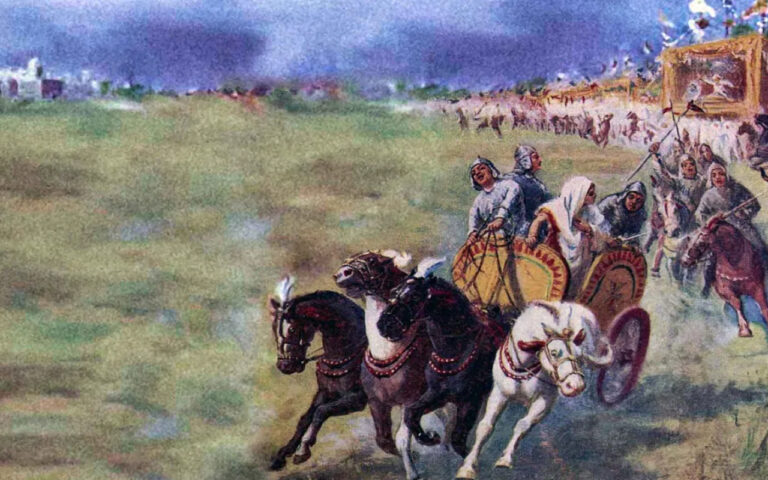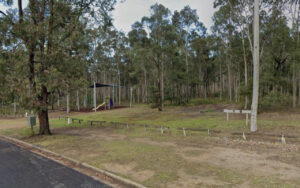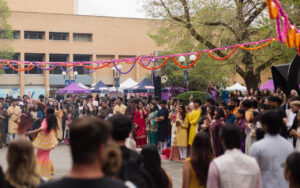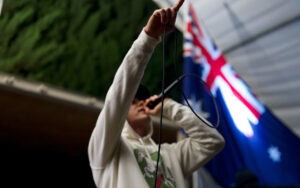The theory of an ancient Aryan invasion of the Indian subcontinent was first proposed by William Jones, a British philologist in the 18th Century. At the time a stunning and original theory, Jones proposed a common root language to European languages and Sanskrit, writing that:
The Sanscrit language, whatever be its antiquity, is of a wonderful structure; more perfect than the Greek, more copious than the Latin, and more exquisitely refined than either, yet bearing to both of them a stronger affinity, both in the roots of verbs and in the forms of grammar, than could possibly have been produced by accident; so strong indeed, that no philologer could examine them all three, without believing them to have sprung from some common source, which, perhaps, no longer exists. [1]
Observing what he took to be two distinct Aryan and non-Aryan lineages in India, Jones proposed an Aryan conquest of indigenous Indian tribes, bringing the Indo-European Sanskrit language with them. The theory became more popular in the 19th Century, propounded by well-known philologists like Max Müller. It fell out of favour with the end of British colonial rule in India and the mood of anti-racism that gripped intellectuals the world over after WWII.
While Aryan Invasion Theory has been wrongly dismissed as resulting from Western scientific racism, Hindu scholars have also expounded theories on the origin of the invasive Aryans. Dayananda Saraswati, a 19th Century philosopher and founder of a major reform movement in Hinduism, theorised that the Aryans originated in Tibet, arguing that the flora and fauna mentioned in the ancient Rigveda were native to Tibet, and the Aryans worshipped the sun and fire due to Tibet’s extremely cold climate — the ancient Rigveda has 10 hymns dedicated to worship of the sun.
Taking this further, the Indian scholar Bal Gangadhar Tilak wrote a work titled The Arctic Home in the Vedas in 1903, arguing that Aryans originally inhabited the Arctic before being driven from the northern tundras by an Ice Age and migrating to Central Asia. Tilak used a combination of Vedic calendars, analysis of Vedic hymns, and astronomical analysis to conclude the Aryans left their home in the North Pole around 8,000 BC. Traditionalist philosophers Julius Evola and René Guénon later endorsed this theory of a polar origin for the Aryans, with Guénon endorsing Tilak’s reading of the Vedas. [2]
However, although the Aryan Invasion Theory was long comfortably discarded as a relic of Western scientific racism, and its more esoteric proponents had to rely on speculative interpretations of religious texts, modern advances in genetic science have provided more incontrovertible evidence that has only served to vindicate the Aryan Invasion Theory. As I will demonstrate, not only does the genetic record show an enormous Aryan migration to the Indian subcontinent, but the latest evidence attests to this being a violent conquest that utterly transformed India.
The genetic record
In 2019, two major studies were published which gave some of the strongest evidence yet to the theory. And yet, an Indian publication reported that these studies were ignored by media in India, where the theory has been opposed by Indian nationalists. It wrote that:
Much of the Indian media did not bother to explain that the new research actually upheld the theory that people with European Steppe ancestry had brought the Indo-Aryan language branch to India – not overturned it.
At the time of the decline of the Harappan Civilisation — the first Indus Valley Civilisation, which grew alongside Ancient Egypt and Mesopatamia as one of the first agricultural-based civilisations along the fertile Indus River — this founding population began to mix with an Indo-European people carrying the DNA of Steppe peoples. These were the descendants of the Proto-Indo-Europeans who originated in the Pontic-Caspian steppe, whose conquering descendants spread across Eurasia and contribute a significant amount of ancestry to modern Europeans. The Indo-European invaders entered India through Central Asia.
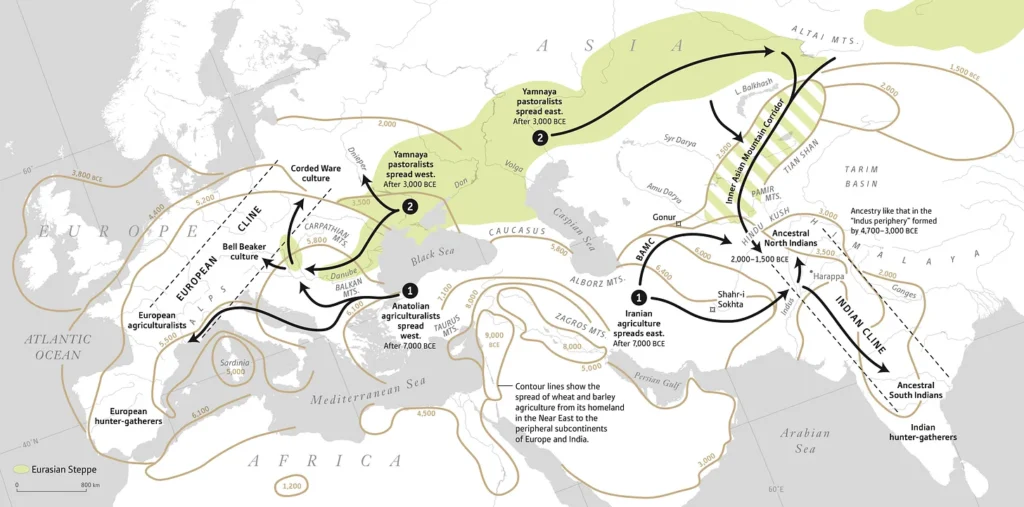
The Indo-European population mixed with the Harappan people to form the Ancestral North Indian (ANI) population. The study found significantly elevated rates of steppe ancestry in Brahmin communities in North India. In the words of one of the co-authors David Reich, the study is “not ambiguous” on proving a foreign origin of Indo-European languages in India.
Interestingly, Reich has also reported an incident where his Indian colleagues threatened to shut down a 2009 research project if the term “West Eurasian” was used to describe this major population group in the North of India, which led to renaming it “Ancestral North Indian” to satisfy Indian nationalist sentiment. Many prominent figures associated with India’s ruling BJP party have made subscription to the discredited “Out of India” theory a prerequisite to Hindu nationalism. For example, the leader of BJP’s parent organisation Rashtriya Swayamsevak Sangh’s (RSS) claims “the DNA of Indians has been the same for 40,000 years.”
Steppe ancestry being concentrated among ethnic Brahmins is interesting, since it has long been theorised that India’s caste system had a racial origin. A 2020 study on the DNA profiles of Brahmin men concluded:
This ethnic group did not originate from a single ancestral population, but instead emerged from at least 12 progenitors who, with one exception (haplogroup H), emerged from foreign lands that were geographically near or coterminous with India. [3]
The Indo-European ancestors of the Brahmins:
Brought Sanskrit and tenets of the Vedic religion with them. After the demise of IVC, starting around the second millennium BCE, some inhabitants, mostly the newcomers, remained in the north and others dispersed to the eastern and southern parts of India, resulting in the ANI [Ancestral North Indian] and ASI [Ancestral South Indian] population clusters. Over time, the Brahmins expanded and spread Hinduism throughout the Indian subcontinent. [4]
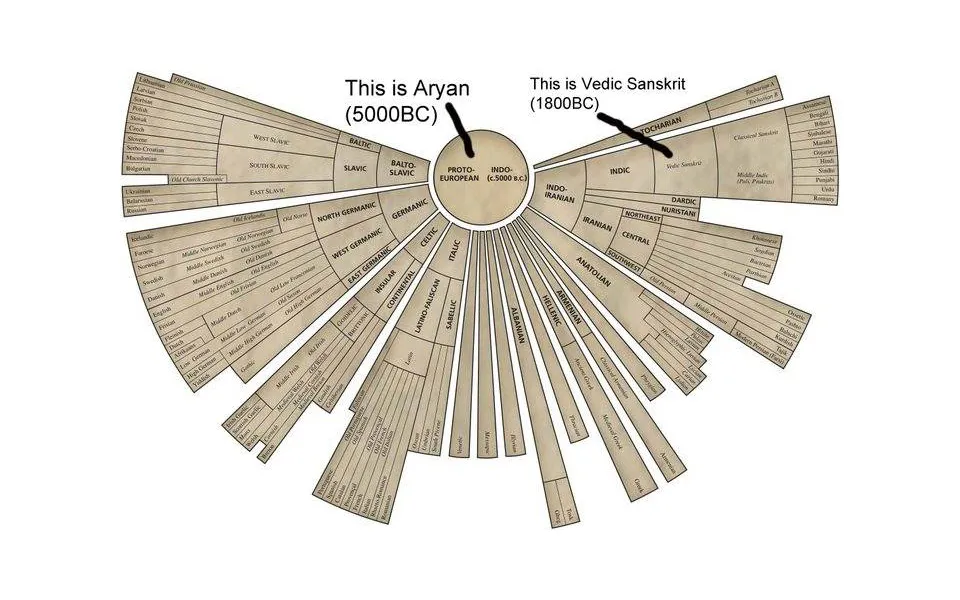
The Brahmins maintained the dominance of Sanskrit, the oldest existing Indo-European language in India. Reflecting the pattern of Sanskrit being enforced by the Aryan invaders, older Dravidian languages are dominant in the South of India.
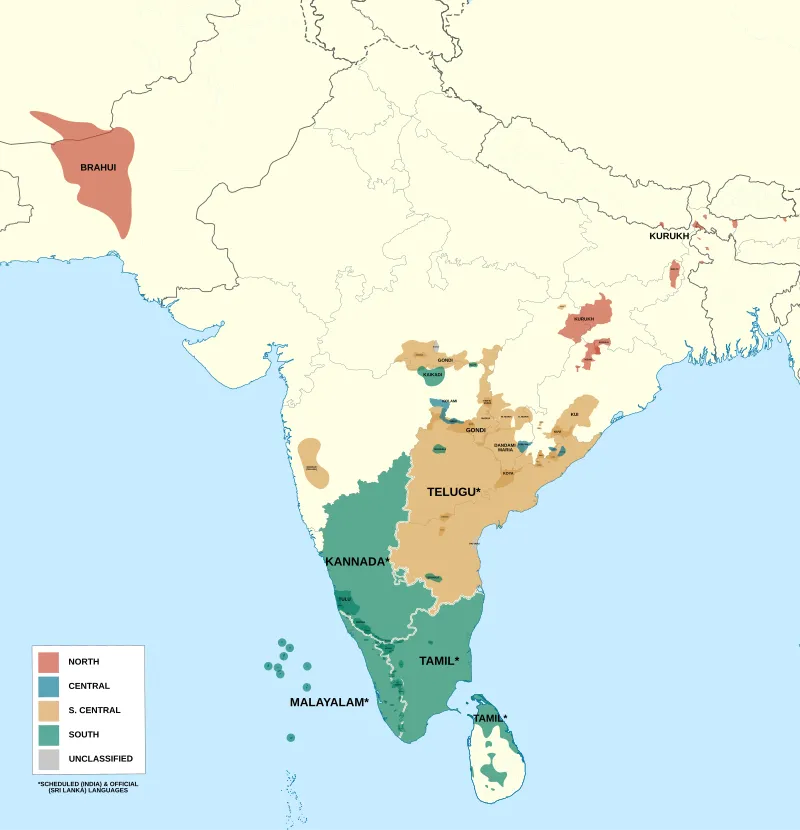
This is reminiscent of Mediterranean Europe, which has far lower Steppe ancestry than Northern and Central Europe and where many non–Indo-European languages are reported still existing in classical sources.
The study notes that by the time of the Aryan arrival to India in the second millennium BC, the Indus Valley Civilisation was already in decline, and DNA evidence suggests the Aryan invaders rapidly dislodged the existing elite and dominated the region.
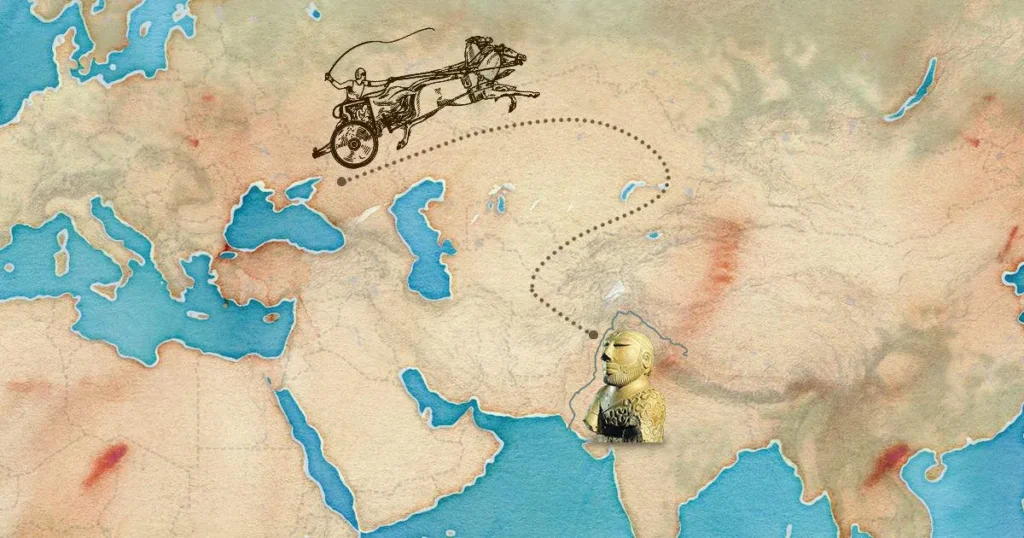
However, genetic and archaeological evidence has shown that these Indo-European invaders of India did not come directly from the steppe, but actually originated from people of the kind we find in the Corded-Ware culture of Central and Eastern Europe. These Corded-Ware populations had mixed with early European farmers and are most closely related to modern Northern Europeans:
Many of the samples from this group are individuals buried in association with artifacts of the Corded Ware, Srubnaya, Petrovka, Sintashta and Andronovo complexes, all of which harbored a mixture of Steppe_EMBA ancestry and ancestry from European Middle Neolithic agriculturalists (Europe_MN). This is consistent with previous findings showing that following westward movement of eastern European populations and mixture with local European agriculturalists, there was an eastward reflux back beyond the Urals. [5]
So while Proto-Indo-Europeans expanded out of the Pontic-Caspian Steppe in all directions, it was their later Northern European branch which mixed with native European farmers that then expanded back eastward and became the founders of Vedic civilisation.
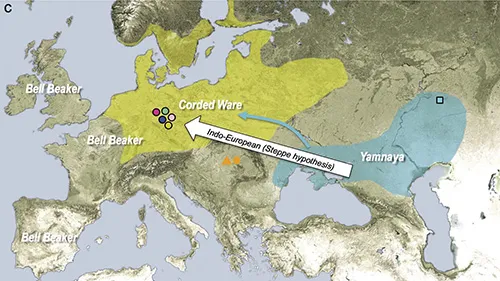
The R1a DNA associated with the Indo-European expansion into India is found most in Southern Central Asia and Iran, and concentrated in the Northwest of India where the Aryan invasions would have begun. In Europe, its spread looks like this:
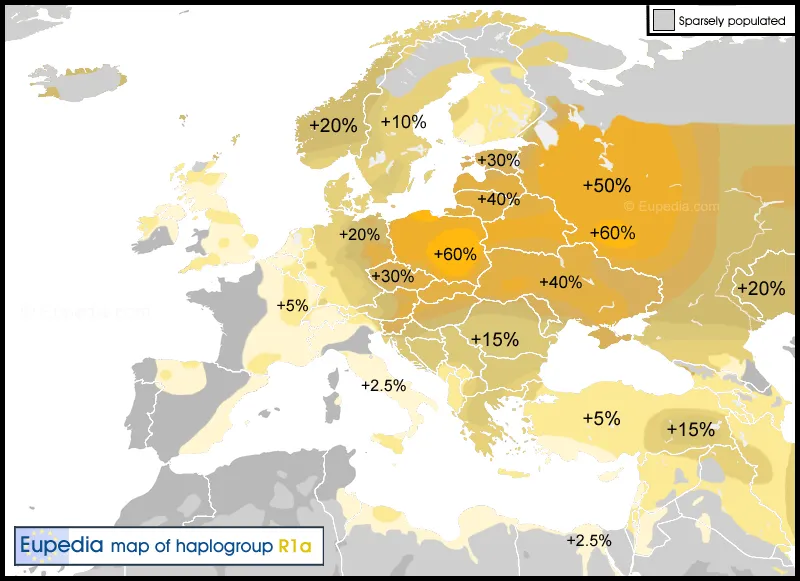
It’s important to note that had the origin of steppe DNA in India been the earlier Yamnaya culture, then males in the region would carry the R1b marker rather than the later R1a. But, as a 2018 study notes:
Early Bronze Age Yamnaya-related migrations had limited direct genetic impact in Asia. [6]
That R1a is what is present in the region shows that the entrance of Indo-Europeans came from a later European expansion:
The Steppe ancestry in South Asia has the same profile as that in Bronze Age Eastern Europe, tracking a movement of people that affected both regions and that likely spread the distinctive features shared between Indo-Iranian and Balto-Slavic languages. [7]
An article in the Journal of Human Genetics points to a series of migrations to India in 2,000-1,500 BC that was transformative to the region, and overwhelmingly male dominated.[8] 40% of the male lineages of northern India carry the R1a DNA marker associated with the Indo-European invasion, compared to less than 10% of female lineages. In other words, while critics of the Aryan Invasion Theory have tried to recast it as one among many simple migrations to India, it was anything but peaceful.
Over a millennium later, during Alexander the Great’s attempted conquest of the Indian subcontinent, the Brahmin descendants of this European invasion were noted for engineering particularly fierce resistance to the Macedonian. The Brahmins incited a holy war all along his invasion route, creating the toughest challenge of all his invasions. One of the subsequent battles led to Alexander being wounded badly enough to prompt a retreat from India.
Vedic sources on the Aryan conquest
As mentioned, faced with the incontestable genetic evidence of a large influx of steppe populations into India, some have proposed an “Aryan Assimilation Theory” and argued this influx was gradual and peaceful. This is not only challenged by the genetic record showing a male-dominated invasion, but also from the historical record provided by ancient Indian sources.
Written between 1,500-1,000 BC, the Rigveda is one of the foundational Hindu texts — one of the four Vedas, and the oldest Vedic Sanskrit text. It records the story of the Aryan incursion into India and their encounter with the local populations.
The Indo-Iranian peoples apparently referred to themselves as “Aryans”, meaning “noble” or “civilised”. An inscription on the tomb of Darius the Great uses the term “Ariya” to describe the Iranian people, apparently describing Darius as an “Aryan of Aryan descent.” In Avestan, the liturgical language of Zoroastrianism, “Airyanem Vaejah” is used to describe an ancient “Aryan expanse” which was the homeland of the Iranian people. Similarly, the Sanskrit term ārya, meaning noble, is used throughout the Rigveda to describe the conquerors who subdued the native Indians, who are referred to as Dasa/Dasyu.
Indra, the principal deity of the Rigveda, is a Vedic-Aryan deity who the Aryans petition as a god of war. He is frequently depicted enjoying soma, an ancient drink identified with ancient steppe cultures. Soviet archaeologists identified the Bactria Margiana Archaeological Complex (BMAC), a Bronze Age civilization that existed in the Pamir mountains in modern Tajikistan around 4,000 BC. Among the remains of this ancient culture were alters; cannabis; four-wheeled chariots and horse sacrifices; and ephedra, one of the ingredients for soma. The soma-drinking practices of Indo-Europeans are documented in other ancient sources.
Although partly mythical, the Rigveda was written near the time of Aryan incursions into India, and its many descriptions of the fair-skinned Aryan invaders contrasted to the dark-skinned, “snubnosed”, godless natives seems to record real events.
Indra and his light-skinned friends conquer the land:
“He (Indra), much invoked, hath slain Dasyus and Simyus, after his want, and laid them low with arrows. The mighty Thunderer with his fair-complexioned friends won the land, the sunlight, and the waters. May Indra evermore be our protector, and unimperilled may we win the booty” [RV Hymn C, 18–19]
Aryan invaders slay “darksome creatures”:
“Day after day far from their seat he (Indra) drove them, alike, from place to place, those darksome creatures. The Hero slew the meanly-huckstering Dasas, Varcin and Sambara, where the waters gather.” [RV 6.47.21]
The Aryans drive out a “dusky brood”:
SING, with oblation, praise to him who maketh glad, who with Rjisvan drove the dusky brood away. Fain for help, him the strong whose right hand wields the bolt, him girt by Maruts we invoke to be our Friend. [RV 1. 101. 1]
Indra conquers to spread the might and glory of the Aryans:
Armed with his bolt and trusting in his prowess he wandered shattering the forts of Dasas. Cast thy dart, knowing, Thunderer, at the Dasyu; increase the Arya’s might and glory, Indra. [RV 1. 103. 3]
The aboriginals of India are cursed with “dusky skin”
Indra in battles help his Aryan worshipper, he who hath hundred helps at hand in every fray, in frays that win the light of heaven. Plaguing the lawless he gave up to Manu’s seed the dusky skin; Blazing, ’twere, he burns each covetous man away, he burns, the tyrannous away. [RV 1. 130. 8]
The “swarthy fifty thousand” are defeated:
Thou to the son of Vidathin, Rjisvan, gavest up mighty Mrgaya and Pipru. Thou smotest down the swarthy fifty thousand, and rentest forts as age consumes a garment. [RV 4. 16. 13]
Indra hates “swarthy skin”:
O’er Sire and Mother they have roared in unison bright with the verse of praise, burning up riteless men, blowing away with supernatural might from earth and from the heavens the swarthy skin which Indra hates. [RV 9. 73. 5]
Indra is described with a yellow beard and yellow hair
At the swift draught the Soma-drinker waxed in might, the Iron One with yellow beard and yellow hair. He, Lord of Tawny Coursers, Lord of fleet-foot Mares, will bear his Bay Steeds safely over all distress. [RV 10. 96. 8]
Indra bestows the land to White people:
The Thunderer bestowed on his White friends the fields, bestowed the sun, bestowed the waters. [RV 1. 100. 18]
More passages on black skin:
Indra protected in battle the Aryan worshipper, he subdued the lawless for Manu, he conquered the black skin. [RV 1. 130. 8]
Stormy gods who rush on like furious bulls and scatter the black skin. [RV 4. 73.5]
Indra, the manifold protector (of his worship) battles, defends his Aryan worshipper in all conflicts, in conflicts that confer heaven. He punished for (the benefit of) man the neglecters of religious rites. He tore off the black skin (of the aggressor), as if burning (with flame), he consumes the malignant; he utterly consumes him who delights in cruelty. [RV 1. 130. 8]
Natives are described as Godless, lawless and inhuman:
Thou conqueredst, boundest many tribes for ever. Like castles thou hast crushed the godless races, and bowed the godless scorner’s deadly weapon. [RV 1. 174. 8]
The foolish, faithless, rudely-speaking niggards, without belief or sacrifice or worship,— Far far away hath Agni chased those Dasytis, and, in the cast, hath turned the godless westward. [RV 7. 4. 3]
These final passages especially don’t help the case of proponents of Aryan Assimilation Theory, who might argue the Aryans merely adopted existing Vedic religion. The Vedas are clear that the religious practices of the natives were considered without virtue and practicing a demonic, inferior religion.
The blonde-haired Indra is the central deity of the Rigveda. Many scholars have seen in Indra the same deity as Thor and Zeus, reflecting their Indo-European origins. The Swedish archaeologist Oscar Montelius remarked that:
Amongst the Aryan peoples of India we find a god whose favourite weapon in his fight against the demons is the thunderbolt. This god, glorified above all others in the Rigveda hymns, was Indra, that fabulously strong deity who corresponds to the Thor of the Scandinavians. His original weapon was the “heavenly stone” which the primeval smiths had sharpened for him; it was thus a kind of stone axe. Then a bolt was prepared for him which, according to some hymns, was made out of the skull of a horse, while others describe it as being made of bronze. Strictly speaking, it was made of “ayas,” the same word as the Latin “aes,” which word in the earlier Indian language signifies copper or bronze, but which in later times, after iron became known, means this new metal. From the fact that one of the Rigveda hymns gives to the lightning the name of the axe of heaven, we may rightly infer that Indra’s axe is really the lightning.[9]
Like Thor, Indra is considered the god of thunder, but he is also represented as the sun. Montelius and other scholars have argued that the god of the sun and of thunder had originally been the same in Indo-European mythology, with some depicting this god as wielding an axe and some a hammer. This god reflects the pole of a more fundamental conflict that animates Indo-European mythology:
As far back as written accounts extend, the struggle between Light and Darkness, Summer and Winter, Good and Evil, has formed the principal foundation of the religious belief of the people of the North.[10]
Horses in Vedic Civilisation
Another notable aspect of the Rigveda is how prominently horses are featured. Horses are mentioned 215 times in the text, far more than any other animal. The twin Ashvin gods are described as horsemen. Ushas, the most exalted goddess in the Rigveda, and Agni, one of the principal male deities, are both described as riding horse-drawn chariots.
This is significant because in the Harappan civilisation, there are hardly any traces of horses, either as skeletal remains nor engraved as images on any artefacts. Even before genetic advances totally rebuked proponents of Indigenous Aryanism, its proponents in India had to claim Harappan civilisation was Vedic, but were at a complete loss to explain the absence of horses in this civilisation and their sudden appearance in the Vedas. This is all the more conspicuous considering many of the terracotta seals recovered from Harappan sites are engraved with various animals, but never horses.
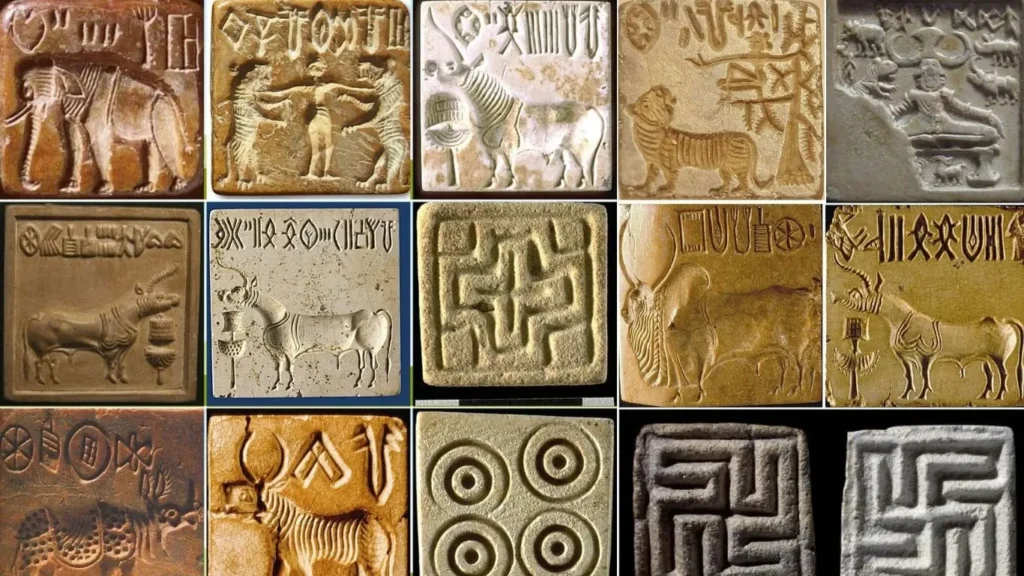
We now know the native population of wild horses had disappeared from India by about 8,000 BC, and only ancestors of the Indian wild ass remained. It was the incursion of the Indo-Aryan steppe population that brought domesticated horses to India, and they are featured so prominently in the Vedas because they are of Aryan origin.
Horses were crucial to the success of the Proto-Indo-European peoples, providing a great military advantage that allowed their vast conquests over peoples without horses. They were also central to the pastoral economies of the Proto-Indo-Europeans, likely used a lot for herding the livestock of these nomadic populations. As such, horses were revered in Indo-European cultures.
Horses were connected with the cult of the sun deity and seemed to have magical powers attributed to them. Hippomancy, divination through horses, was widespread among Indo-European groups. It was believed the future success or failure of a military enterprise could be judged by the snorting of a horse.
One of the great markers of Indo-European culture is the horse sacrifice, “one of the most enduring and widespread traditions in world history.”[11] The archaeological record shows evidence of elaborate ritualistic sacrifices of horses in Celtic, Germanic and Slavic cultures. Vedic India too, carried forward this Indo-European tradition in the form of the Ashvamedha — literally meaning “horse sacrifice”.
This ritual involved the release of a stallion, allowed to roam freely for one year with the escort of the king’s army. During this time, any incursions into neighbouring territories was seen as an assertion of sovereignty. The horse would be sacrificed on its return following an elaborate religious ritual, which included the queen being stimulated with the penis of the dead horse as a fertility ritual.
Traditionally, handling of horses was kept to the Kshatriyas, or warrior caste. Lower caste Dalits riding or handling horses was seen as a great insult and challenge to the power of the ruling castes. This attitude is still present in India today, where Dalits have been killed for owning horses. If there was a racial division in the original caste system between invasive Aryans for whom horses were such a central part of their traditions and military success, and natives whose adoption of horses might have been seen as a threat to their conquerors, this would help explain why this particular division was so strongly enforced.
Race in the caste system
The word “caste” is derived from the Spanish and Portuguese word casta, which roughly translates to breed or race. This stuck after Portuguese explorers used the term for the Indian system after encountering it in the 15th Century. The “caste system” now generally refers to the Indian system of jāti, which is a more complex and localised system of hierarchies than the broad categorisations we associate with caste.
This is closer to the Indian varna system, from where we get the traditional social groups of:
- Brahmins (priests & scholars)
- Kshatriyas (warriors, rulers, administrators)
- Vaishyas (merchants, agriculturists, artisans)
- Shudras (labourers, service providers)
A fifth class of Dalits or “Untouchables” was excluded from the fourfold varna system and considered fit only to perform undesirable menial work. They were also considered impure since their typical occupations often involved tasks considered to be ritually polluting, such as removing human waste.
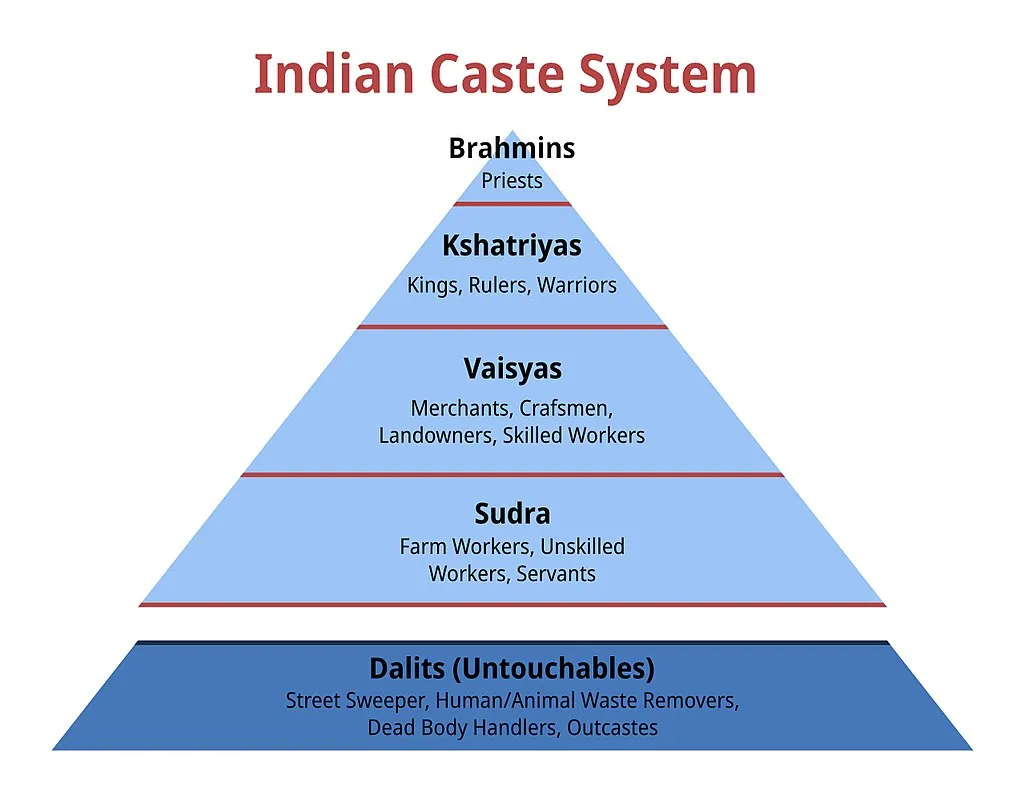
The term varna itself literally translates to “colour”. In the epic Mahabharata, written in the 4th Century AD, a sage named Bhrigu identifies each varna with a particular colour: “Brahmins Varna was white, Kshtriyas was red, Vaishyas was yellow, and the Shudras’ black.”[12] This is rebuked by another sage, who argues the colours are present among all varnas and what really distinguishes them is behaviour.
Could this reflect a progression of the understanding of the varna system, which was originally based on observable racial differences which became less solidified with time? These colours are now taken to represent the different Gunas or qualities — white represents Satva (purity and knowledge), Red represents Rajas (activity) and Black represents Tamas (destruction).
However, while rebuking Bhrigu, his interlocutor acknowledges that Bhrigu himself is indeed talking about complexion:
If the distinction between the four varnas is only on the basis of complexion and that is how the varnas are to be differentiated, then it is evident and can be seen that among the varnas, there has been a mixture of varnas.
So while later scriptures reject a racial foundation to the varnas, it does seem to be acknowledged that a division based on complexion and racial qualities had at one time been the prevailing view.
The earliest theorists of the Aryan Invasion Theory believed the different racial qualities of the major castes suggested it had once been a means of the Aryan invaders differentiating themselves from the darker-skinned natives. What can we surmise about this today?
The large study on Indian population changes cited at the beginning of this article reports the following:
We report genome-wide data from 73 groups from the Indian subcontinent and analyze linkage disequilibrium to estimate ANI-ASI mixture dates ranging from about 1,900 to 4,200 years ago. In a subset of groups, 100% of the mixture is consistent with having occurred during this period. These results show that India experienced a demographic transformation several thousand years ago, from a region in which major population mixture was common to one in which mixture even between closely related groups became rare because of a shift to endogamy.[13]
In other words, around the time Aryans began to arrive in India, there was a sudden shift from free mixing between groups to caste-based endogamy. Initially, the male Aryan invaders likely engaged in a lot of rape and mixing with the local populations.
The confusion of so many mixed offspring not clearly belonging to one or the other groups is probably what led to the institution of a caste system, which gradually became institutionalised. Indeed, the genetic record attests to high-caste Indians with a high ANI (West Eurasian) DNA mating outside of their caste but not allowing the resulting mixed offspring to enter their caste. Per a 2016 genomic study on India:
In eastern and northeastern India, populations such as the West Bengal Brahmins (WBR) and the TB populations continued to admix until the emergence of the Buddhist Pala dynasty during the 8th to 12th centuries CE. The asymmetry of admixture, with ANI populations providing genomic inputs to tribal populations (AA, Dravidian tribe, and TB) but not vice versa, is consistent with elite dominance and patriarchy. Males from dominant populations, possibly upper castes, with high ANI component, mated outside of their caste, but their offspring were not allowed to be inducted into the caste.[14]
So in summary, we know that:
- An Indo-European language speaking group who called themselves Aryans entered North India and overturned the existing elite, leaving their genetic mark through a flurry of male mixing with native females
- Genetic and archaeological evidence shows these original invaders belonged to the North European Corded-Ware culture
- The Rigveda describes fair-skinned Aryan invaders conquering dark-skinned natives and imposing a new religion on them
- The caste system began around the time of the Aryan entrance to India
- The caste system was originally described as a colour-based system with the highest castes identified with the colour white and the lowest with the colour black
- Vedic sources as late as the 3rd Century AD say some identified the mark of the varnas as skin colour
- Steppe DNA is focused in the higher castes, who mixed outside their group but whose mixed offspring were excluded from their father’s caste
- Horses were introduced to India by the Aryan invaders, and handling of horses by the lower castes was strictly prohibited
Given these facts, the conclusion that the varna caste system was originally a way for the Aryan invaders to enforce racial divisions between themselves and their conquered populations seems unavoidable.
Modern genetic science has helped us put to bed a centuries old-debate on the origin of the people who created Vedic civilisation. We now know that around three thousand years ago, a war-like Indo-Aryan people, descendants of the Proto-Indo-Europeans of the Pontic-Caspian steppe, invaded India. They conquered and subjugated the native population, imposed the liturgical language of Sanskrit, wrote the Vedas and created Vedic civilisation. Initially mixing widely with the natives, then instituted a caste system along racial lines. The Aryans imposed their aristocratic warrior culture on India; they provided its greatest literary accomplishments in the form of the Vedas; and later the most advanced development of monistic metaphysics in the form of the Upanishads.
Over time, their distinctness was lost as their bloodline blended with the more numerous populations native to the subcontinent. Today, their mark is still found in the genetics of India, especially among the elite Brahmin caste and people in the North-West of India where the Aryan incursions began.
For more on this, I always recommend the excellent work of Survive the Jive:
Footnotes:
[1] Burrow, Thomas. The sanskrit language. Motilal Banarsidass Publ., 2001.
[2] Guénon, René. Traditional forms and cosmic cycles. Sophia Perennis, 2001.
[3] Mahal, David G. “Y-DNA genetic evidence reveals several different ancient origins in the Brahmin population.” Molecular Genetics and Genomics 296, no. 1 (2021): 67-78.
[4] IBID
[5] Narasimhan, Vagheesh M., Nick Patterson, Priya Moorjani, Iosif Lazaridis, Mark Lipson, Swapan Mallick, Nadin Rohland et al. “The genomic formation of South and Central Asia.” Biorxiv (2018): 292581.
[6] de Barros Damgaard, Peter, Rui Martiniano, Jack Kamm, J. Víctor Moreno-Mayar, Guus Kroonen, Michaël Peyrot, Gojko Barjamovic et al. “The first horse herders and the impact of early Bronze Age steppe expansions into Asia.” Science 360, no. 6396 (2018): eaar7711.
[7] Moorjani, Priya, Kumarasamy Thangaraj, Nick Patterson, Mark Lipson, Po-Ru Loh, Periyasamy Govindaraj, Bonnie Berger, David Reich, and Lalji Singh. “Genetic evidence for recent population mixture in India.” The American Journal of Human Genetics 93, no. 3 (2013): 422-438.
[8] ArunKumar, GaneshPrasad, Tatiana V. Tatarinova, Jeff Duty, Debra Rollo, Adhikarla Syama, Varatharajan Santhakumari Arun, Valampuri John Kavitha et al. “Genome-wide signatures of male-mediated migration shaping the Indian gene pool.” Journal of human genetics 60, no. 9 (2015): 493-499.
[9] Montelius, Oscar. “The Sun-God’s Axe and Thor’s Hammer.” Folklore 21, no. 1 (1910): 60–78. http://www.jstor.org/stable/1253798.
[10] Worsaae, Jens Jacob Asmussen. The industrial arts of Denmark from the earliest times to the Danish conquest of England. Vol. 1. Chapman and Hall, 1882.
[11] Kaliff, Anders, and Terje Oestigaard. The Great Indo-European Horse Sacrifice: 4000 Years of Cosmological Continuity from Sintashta and the Steppe to Scandinavian Skeid. Uppsala universitet, 2020.
[12] Hiltebeitel, Alf. Dharma: Its early history in law, religion, and narrative. Oxford University Press, 2011.
[13] Moorjani, Priya, Kumarasamy Thangaraj, Nick Patterson, Mark Lipson, Po-Ru Loh, Periyasamy Govindaraj, Bonnie Berger, David Reich, and Lalji Singh. “Genetic evidence for recent population mixture in India.” The American Journal of Human Genetics 93, no. 3 (2013): 422-438.
[14] Basu, Analabha, Neeta Sarkar-Roy, and Partha P. Majumder. “Genomic reconstruction of the history of extant populations of India reveals five distinct ancestral components and a complex structure.” Proceedings of the National Academy of Sciences 113, no. 6 (2016): 1594-1599.
This article originally appeared on Keith Woods’ Substack and is republished by The Noticer with permission.
His book Nationalism: The Politics of Identity is now available on Amazon. If you enjoy his writings, please consider purchasing it and leaving a positive review.
